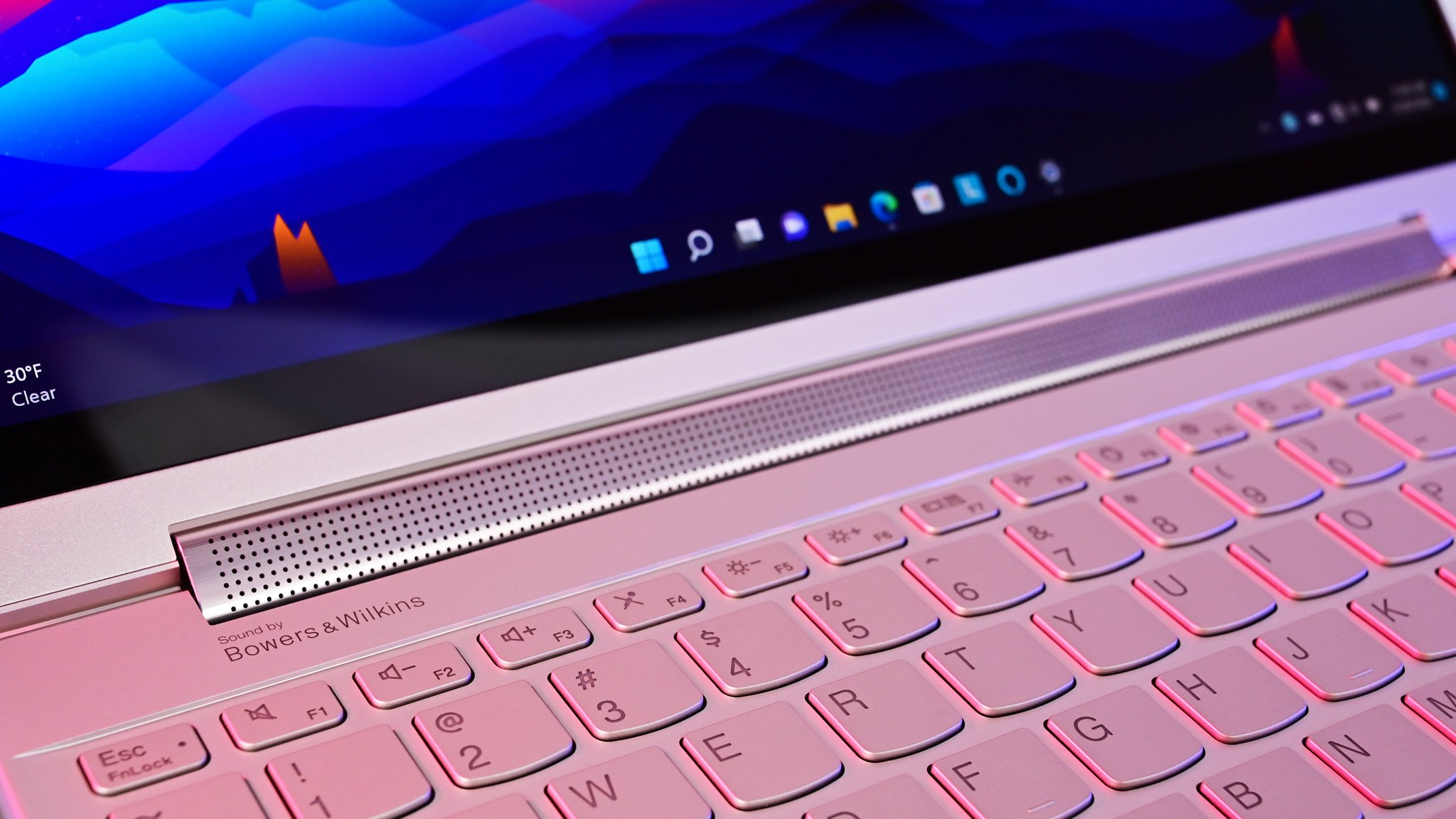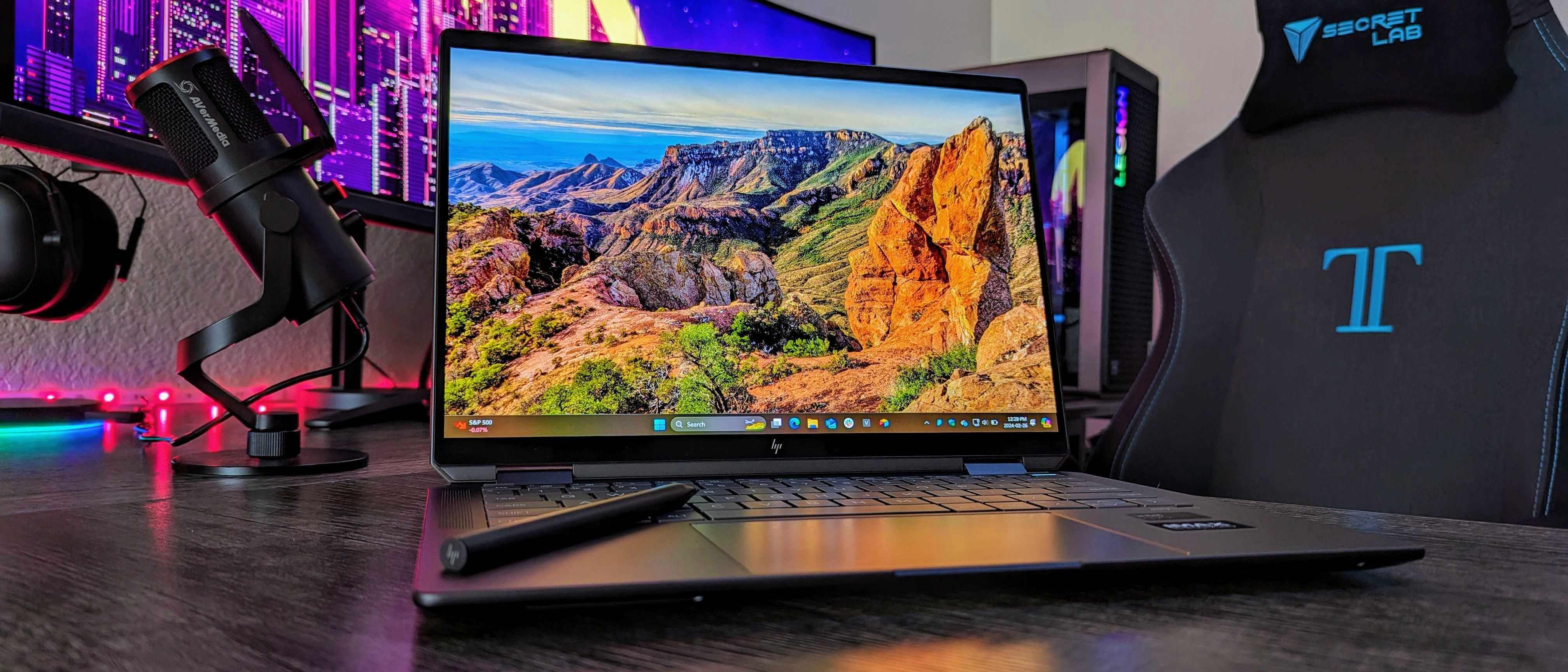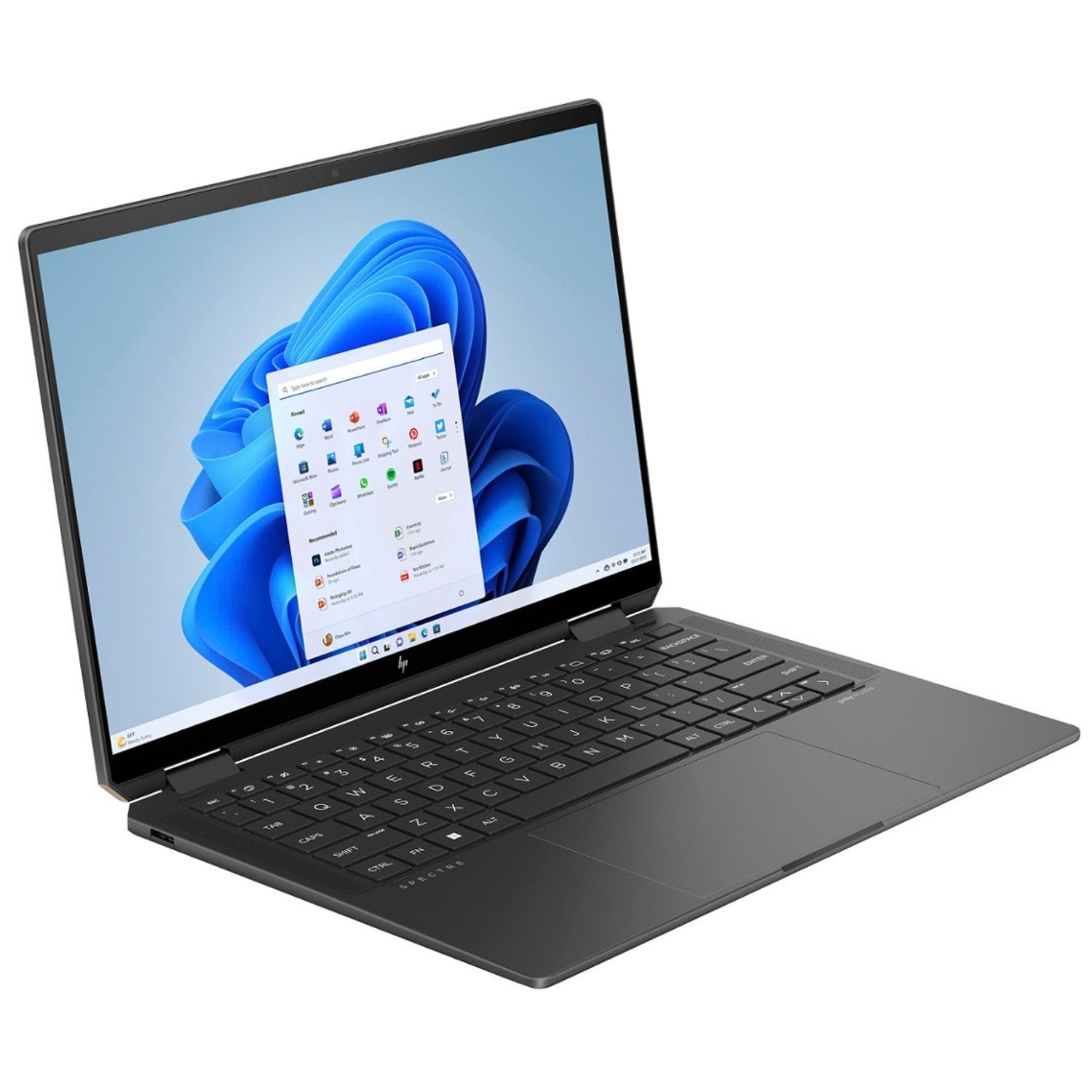
HP's Spectre x360 14 for 2024 is a well-rounded convertible laptop with premium design and features. It performs very well, its battery life is solid, and the 2.8K OLED touch display is a treat for the eyes. It's not quite as exciting as the Yoga 9i with the soundbar hinge and optional 4K display, but it's going to attract a lot of people thanks to competitive pricing and frequent discounts.
Pros
- 2.8K OLED touch display is outstanding
- Snappy Intel Core Ultra performance
- Frequent discounts make it more affordable
- 9MP webcam with IR/HPD
- Wi-Fi 7
Cons
- No UHD+ display option
- RAM is soldered
- One fewer port
- Slightly heavier and thicker
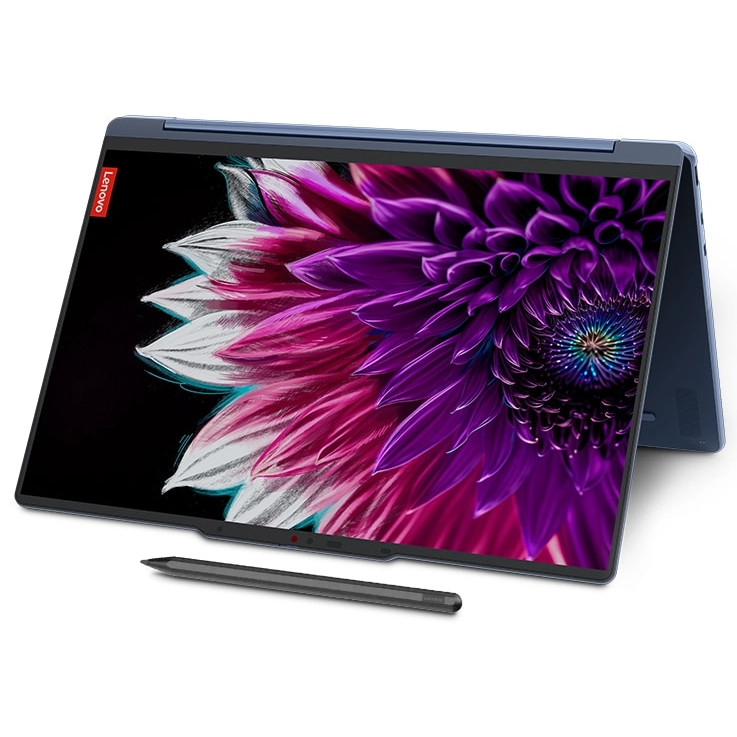
Lenovo's Yoga 9i 2-in-1 (Gen 9) was refreshed for 2024 with new performance hardware, a better webcam, and a boosted refresh rate for its 2.8K OLED display. It's a stellar choice for anyone who uses a laptop instead of a TV, but it'll also serve you well as a productivity machine. High-end models with UHD+ display are priced very competitively, though HP seems to win on the lower-end model pricing.
Pros
- 2.8K and UHD+ OLED touch display options
- Soundbar hinge is hard to beat
- Starts at a competitive price
- 5MP camera with IR/HPD
- One extra port
Cons
- Only one CPU option
- RAM is soldered
- Lower-res camera
- No Wi-Fi 7
HP and Lenovo offer some of the best laptops today, and each company unveiled upgraded flagship convertible PCs earlier this year. In HP's Spectre x360 14 announcement at CES 2024, it was revealed that the laptop has changed from a 3:2 aspect ratio to 16:10, picked up some new Intel Core Ultra performance hardware, and boosted some of its best features, including the webcam.
Lenovo also used CES 2024 to unveil the Yoga 9i 2-in-1 (Gen 9), with the laptop remaining almost identical to the previous generation's design but picking up a new Cosmic Blue color. It's mostly a performance refresh featuring Intel's latest mobile chips, but the 2.8K OLED display also has a higher refresh rate and the camera is now 5MP instead of 1080p.
These laptops cost roughly the same when they're not on sale, and it's no doubt a tough decision for anyone shopping for a premium convertible laptop. Let's take a deep dive into the similarities and differences to help you make the right decision.
HP Spectre x360 14 (2024) vs. Lenovo Yoga 9i (Gen 9): Specs
It's worth taking a look at the raw specs available in each of these convertible laptops before we get into a more detailed breakdown of design, features, display, and performance.
| Header Cell - Column 0 | HP Spectre x360 14 (2024) | Lenovo Yoga 9i 2-in-1 (Gen 9) |
|---|---|---|
| CPU | Intel Core Ultra 5 125H, Core Ultra 7 155H | Intel Core Ultra 7 155H |
| RAM | 16GB, 32GB LPDDR5x-7467MHz (soldered) | 16GB, 32GB LPDDR5x-7467MHz (soldered) |
| GPU | Intel Arc (integrated) | Intel Arc (integrated) |
| Storage | 512GB, 1TB, 2TB M.2 PCIe 4.0 NVMe SSD (upgradeable) | 512GB, 1TB M.2 PCIe 4.0 NVMe SSD (upgradeable) |
| Camera | 9MP IR, privacy shutter, human presence detection | 5MP IR, privacy shutter, human presence detection |
| Speakers | Dual 2W tweeters, dual 2W woofers, DTS:X Ultra | Dual 2W tweeters, dual 2W woofers, Dolby Atmos, soundbar hinge |
| Display | 14 inches, 2880x1800 (2.8K), OLED, touch, 120Hz variable refresh rate, 400 nits SDR, anti-reflective, VESA DisplayHDR 500, IMAX Enhanced, pen support | 14 inches, 2880x1800 (2.8K), OLED, touch, 120Hz variable refresh rate, 400 nits SDR, glossy, Dolby Vision, VESA DisplayHDR True Black 500, pen support |
| Row 7 - Cell 0 | Row 7 - Cell 1 | 14 inches, 3840x2400 (UHD+), OLED, touch, 60Hz, 400 nits SDR, glossy, Dolby Vision, VESA DisplayHDR True Black 500, pen support |
| Ports | Two Thunderbolt 4, USB-A 3.2 (Gen 1), 3.5mm audio | Two Thunderbolt 4, USB-C 3.2 (Gen 2), USB-A 3.2 (Gen 2), 3.5mm audio |
| Wireless | Wi-Fi 6E, Wi-Fi 7, Bluetooth 5.3/5.4 | Wi-Fi 6E, Bluetooth 5.3 |
| Battery | 68Wh | 75Wh |
| Dimensions | 12.35 x 8.68 x 0.67 inches (313.6mm x 220.4mm x 18mm) | 12.44 x 8.66 x 0.63 inches (316mm x 220mm x 15.9mm) |
| Weight | 3.19 pounds (1.44kg) | 2.91 pounds (1.32kg) |
| Price | From $1,450 | From $1,477 |
HP Spectre x360 14 (2024) vs. Lenovo Yoga 9i (Gen 9): Price and availability
HP's Spectre x360 14 for 2024 is readily available at HP's website, with prices starting at about $1,450 before any discounts. The introductory models include a Core Ultra 5 125H CPU, 16GB of RAM, 512GB M.2 solid-state drive (SSD), and the 2.8K OLED touch display. At the time of writing, HP has knocked $350 off the price, bringing the total down to just $1,100.
A high-end option with a Core Ultra 7 CPU, 16GB of RAM, 2TB SSD, and the same 2.8K OLED touch display normally costs about $1,850. Again, at the time of writing, HP has it discounted by $350, bringing the total down to $1,500.
It seems like HP has been running some sort of promotion for the Spectre x360 14 since it launched, so you'll no doubt want to wait for a sale if you're interested in buying. You can also find pre-built models for sale at Best Buy, but it doesn't seem like they include an active pen like at the HP website. If you're interested in configuring each component, you'll also want to stick with HP's website.
On Lenovo's side, the 14-inch Yoga 9i 2-in-1 (Gen 9) for 2024 was only very recently launched; however, Lenovo's website has a configurator that allows you to choose individual hardware.
Prices start at about $1,477 for a model with Core Ultra 7 155H CPU, 16GB of RAM, 512GB SSD, and the 14-inch 2.8K OLED touch display. That's a very competitive price even before any discounts. An active pen is included in your purchase.
It's worth noting that the move to a 4K OLED touch display only costs about $80 while doubling the storage capacity only costs about $32. The most you'll spend on a Yoga 9i (Gen 9) with Windows 11 Home is about $1,589. That's more affordable than the Spectre x360 14 before its regular discounts.
- HP Spectre x360 14 (2024) | From $1,450 at HP
- HP Spectre x360 14 (2024) | From $1,630 at Best Buy
- Lenovo Yoga 9i 2-in-1 (Gen 9) | From $1,477 at Lenovo
HP Spectre x360 14 (2024) vs. Lenovo Yoga 9i (Gen 9): Design and features
It's hard to find faults in the design of either of these laptops, and the main takeaway here is that you'll be getting a truly premium convertible laptop with the versatility of tent, stand, and tablet modes when you don't want to work with a standard clamshell form factor.
The Spectre x360 has an aluminum body with rounded edges and cut rear corners (which house a 3.5mm audio jack and a Thunderbolt 4 port), making it comfortable to use no matter its orientation. Port selection is nearly on par with the Yoga 9i, though the Spectre x360 has one extra USB-C 3.2 (Gen 2) port.
Both laptops otherwise offer dual Thunderbolt 4, USB-A 3.2 (Gen 2), and 3.5mm audio. It's worth noting that the USB-A port on the Spectre x360 has a dropjaw design; it's not a dealbreaker by any means, but it isn't quite as convenient as a port that allows you to plug straight in. A quality Thunderbolt dock or hub will go a long way in expanding connectivity for creators or pros who need extra ports.
One standout feature of the Yoga 9i (Gen 9) is its soundbar hinge. It's been a feature for a few generations now, and it remains one of the laptop's best attributes alongside its gorgeous aluminum chassis. Instead of two 360-degree hinges as found in the Spectre x360, Lenovo has one wide hinge that packs in dual 2W tweeters. They rotate with the laptop's display, meaning they'll never be muffled. There are two more 2W woofers on the sides of the laptop, and Dolby Atmos is included for extra optimization.
HP has taken a more standard approach to sound, building dual 2W tweeters into the keyboard surround for top-firing audio. Dual 2W woofers live along the front edge of the laptop, directing sound at the user when it's in standard laptop mode.
Lenovo and HP both know how to make a comfortable keyboard, and which one is better will largely come down to personal preference. It's worth noting that the Yoga 9i (Gen 9) has a Copilot key, while the Spectre x360 does not.
On the touchpad front, you'll again be treated to superb hardware with either laptop. The biggest difference comes down to how the touchpads work. HP has gone with a haptic touchpad that has no moving parts, instead simulating the feel of clicks with haptic hardware below the surface. It's precise, it's large, and it has less of a tendency to break.
The Yoga 9i (Gen 9) still has a mechanical touchpad, but that's not necessarily a bad thing. Many users still prefer the real click. Lenovo makes the most of the available space below the keyboard for a sizable pointing surface.
A fingerprint reader is included in the keyboard area on both laptops, and each device also offers an IR camera for facial recognition through Windows Hello. Windows Studio Effects get a boost from the Neural Processing Unit (NPU) found in the Core Ultra CPUS, and both laptops also feature human presence detection for extra security.
Looking at raw camera hardware, the Spectre x360's 9MP camera should offer a better picture compared to the 5MP camera in the Yoga 9i. Will your work colleagues be able to tell after compression through conferencing apps? Probably not, and it's best to consider both laptops above average in the camera department. Both webcams have a privacy shutter.
HP Spectre x360 14 (2024) vs. Lenovo Yoga 9i (Gen 9): Display
HP's Spectre x360 14 and Lenovo's Yoga 9i (Gen 9) share a similar 14-inch OLED touch display with 2880x1800 (2.8K) resolution. They each have a 120Hz variable refresh rate, around 400 nits of brightness without HDR enabled (climbing closer to 500 nits with HDR), and inking support for the included active pens.
HP used to use a 3:2 aspect ratio, but it made the change to Samsung's 16:10 OLED panel for this generation. It also now uses an anti-reflective finish, which reduces glare while still offering the slick glass finish that works well with touch and inking.
In our Spectre x360 14 (2024) review, Windows Central's Zach Boddy said, "Combined with vibrant (and accurate) colors, respectable standard brightness, the expected perfect contrast, and the joint combination of multitouch and stylus support, there's really little to complain about."
They tested 100% sRGB, 96% AdobeRGB, and 100% DCI-P3 color reproduction, as well as about 382 nits of brightness without HDR enabled.
The 2.8K OLED touch display in the Yoga 9i (Gen 9) offers just about the exact same specs as the one in the Spectre x360. However, Lenovo adds Dolby Vision support and goes with a glossy finish that won't be as good at eliminating glare from bright lighting.
Lenovo also offers an upgraded display if you need more pixels. The touchscreen with a 3840x2400 (UHD+) resolution has an OLED panel as well for deep color and contrast, it hits about 400 nits brightness in SDR (again climbing to about 500 nits with HDR enabled), and it has a glossy finish. Dolby Vision is included, and it tops out at a 60Hz refresh rate.
Both HP and Lenovo bundle an active pen with their laptops when shopping at the official websites. Both offer excellent pressure and tilt sensitivity for a natural feel, and both attach magnetically to the laptop for semi-safekeeping.
Ultimately, those who prefer a UHD+ resolution will need to opt for Lenovo's convertible. However, the 2.8K OLED panel will be enough for plenty of users, and you won't really have to make a major decision based on the screen thanks to both laptops offering the same technology.
HP Spectre x360 14 (2024) vs. Lenovo Yoga 9i (Gen 9): Performance and battery
We've so far only had a chance to benchmark and test the Spectre x360 14 first-hand, but the Yoga 9i's identical performance hardware isn't expected to be far off. There are, however, some configuration differences when it comes to available hardware.
The Spectre x360 14 is available with both Intel Core Ultra 5 125H and Core Ultra 7 155H CPUs, whereas the Yoga 9i sticks with a Core Ultra 7 155H only. That's a bit of a drag for those who don't need the extra performance and would like to save a bit of money, but at least Lenovo seems to have taken this into account with its overall competitive pricing.
The laptops otherwise both offer 16GB or 32GB of soldered LPDDR5x-7467MHz RAM, as well as 512GB or 1TB M.2 PCIe 4.0 NVMe SSDs that can be upgraded after purchase.
Zachary Boddy benchmarked the Spectre x360 14 (2024) with a Core Ultra 7 chip and 32GB of RAM in their review, noting that " it's better than any Ultrabook this thin has a right to be." They also noted that it runs quietly even when the system is under load. As for battery, the laptop lasted just short of 12 hours in PCMark 10's Modern Office rundown, which comes out to about seven to eight hours of real-world multitasking and browsing.

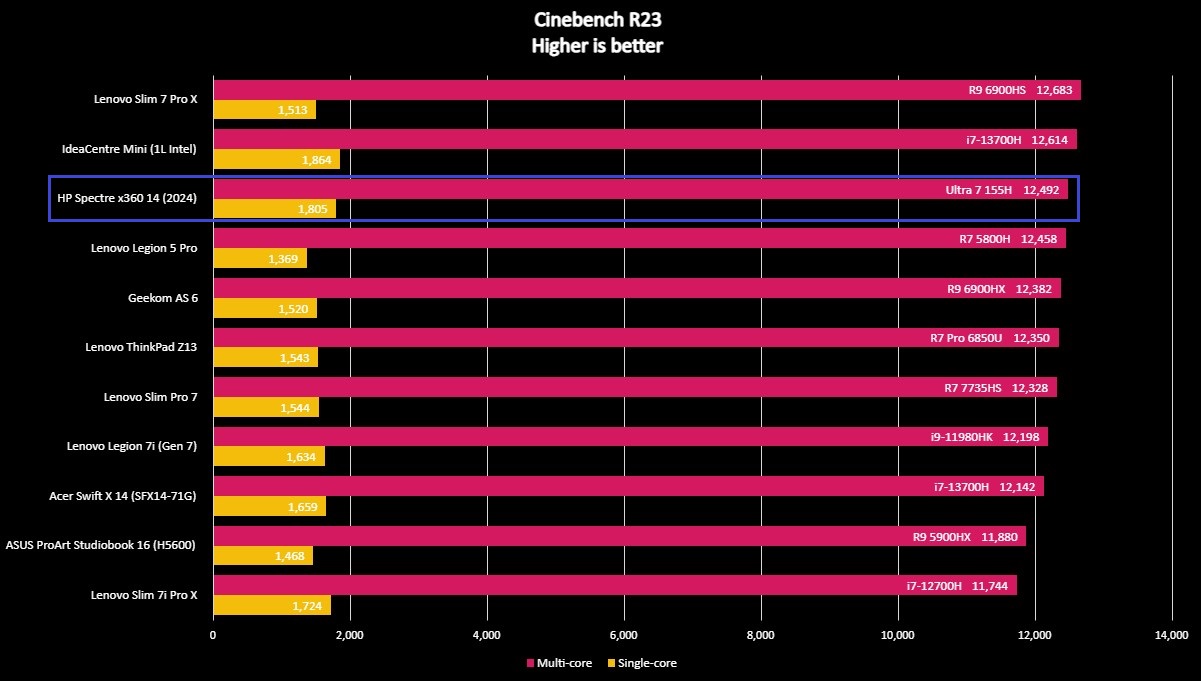

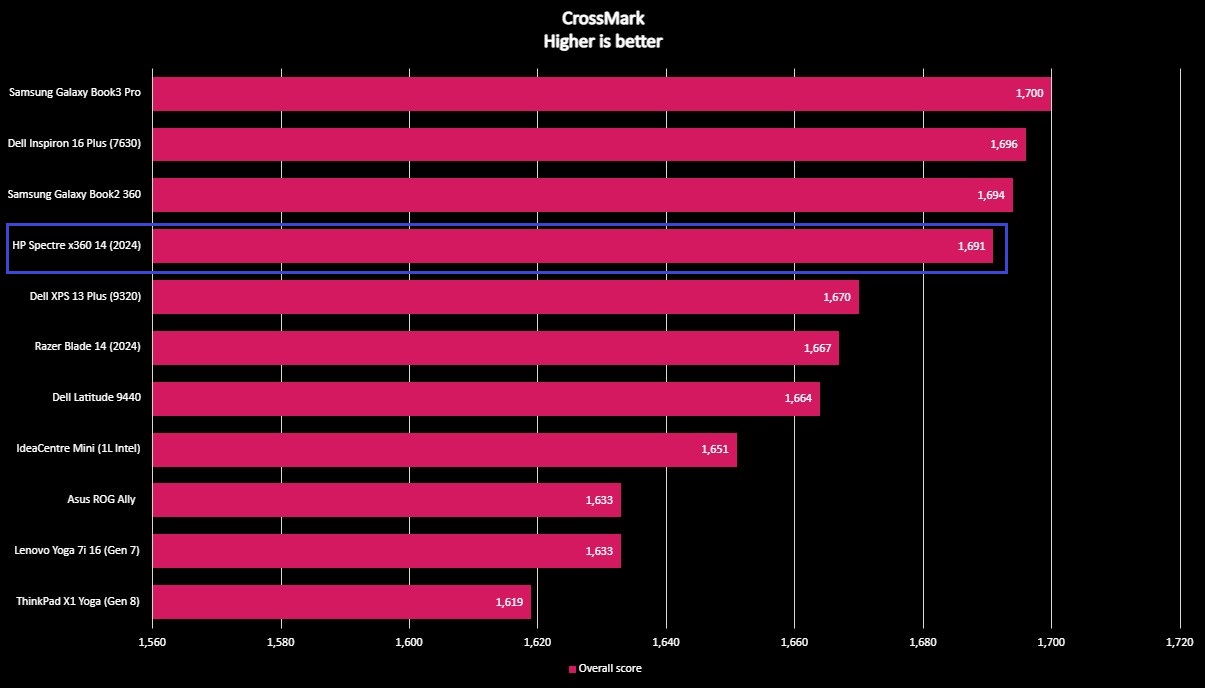


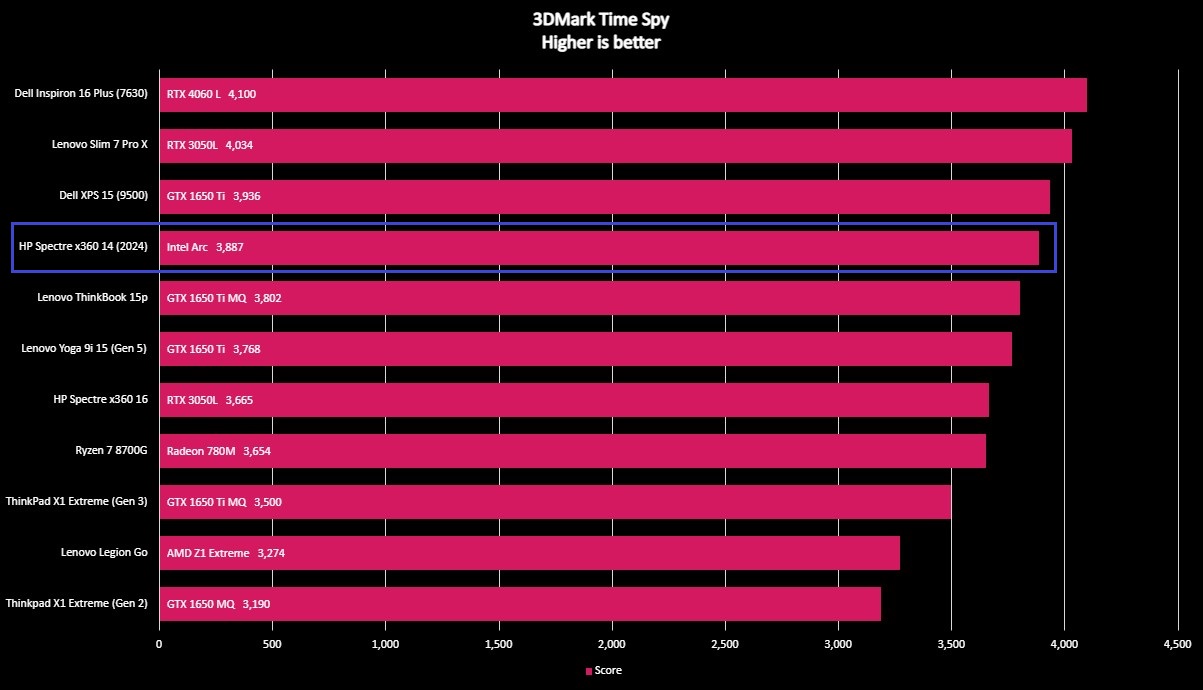
We'll know a lot more about specific performance from the Yoga 9i (Gen 9) when we test and benchmark it ourselves, but for now, it's safe to say that you can expect similar performance from Lenovo's laptop. Battery life will likely come down a bit in models with the high-res UHD+ display, but otherwise, it should offer a similar runtime from a charge.
Intel's Core Ultra chips are efficient and powerful, and that should be no different in the Yoga 9i. One thing to watch out for is wireless performance. HP offers Wi-Fi 7 in its more expensive configs, while Lenovo tops out at Wi-Fi 6E for all models.
HP Spectre x360 14 (2024) vs. Lenovo Yoga 9i (Gen 9): Which should you buy?
Choosing between the HP Spectre x360 14 and Yoga 9i (Gen 9) laptops for 2024 is no doubt a tough decision. I've used the current Spectre models and previous Yoga 9i models and love them both, and I'd recommend them to anyone who wants a convertible laptop with high-end specs and a flawless design.
The Yoga 9i (Gen 9) comes with an optional UHD+ display which might suit some users better, and its soundbar hinge is fantastic for watching movies and TV. That's especially true when combined with Dolby Vision support for its displays. It does, however, have a lower-resolution camera and lacks the option for Wi-Fi 7.
The Spectre x360 14 fills in some of the gaps left by the Yoga 9i, though it does lack one extra USB-C port and doesn't have a UHD+ display option. Nevertheless, there are a couple of CPU options available, it has Wi-Fi 7, and the 9MP webcam is outstanding.
With some deep discounts available for the Spectre x360 14 at the time of writing, I'd lean more toward HP's laptop if you aren't shopping for a high-end model. For about $1,100, you can get one killer laptop with a 2.8K OLED touch display, easily beating Lenovo's introductory $1,477 price. But Lenovo isn't a stranger to great promotions, and its Yoga 9i is a solid value in its own right even at full price. If you're interested in a UHD+ display and extra storage, the Yoga 9i should be seriously considered.
- HP Spectre x360 14 (2024) | From $1,450 at HP
- HP Spectre x360 14 (2024) | From $1,630 at Best Buy
- Lenovo Yoga 9i 2-in-1 (Gen 9) | From $1,477 at Lenovo

The Spectre x360 14 (2024) is one of the best convertible laptops that we've ever reviewed, and frequent discounts only make it more appealing. Unless you need a 4K display or want Lenovo's soundbar hinge, it's likely going to be more attractive to most buyers based on price alone.

Lenovo's Yoga 9i (Gen 9) for 2024 is a refresh of what has long been our favorite laptop. The soundbar hinge, sleek convertible design, and two OLED display options come together to create the ultimate laptop for those love to watch movies and TV on their laptop, and its performance hardware allows it to easily cut through a day's work.
All the latest news, reviews, and guides for Windows and Xbox diehards.

Cale Hunt brings to Windows Central more than nine years of experience writing about laptops, PCs, accessories, games, and beyond. If it runs Windows or in some way complements the hardware, there’s a good chance he knows about it, has written about it, or is already busy testing it.

